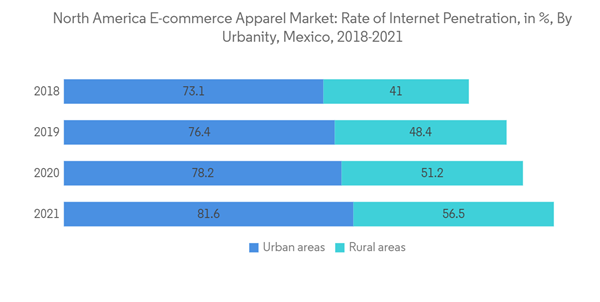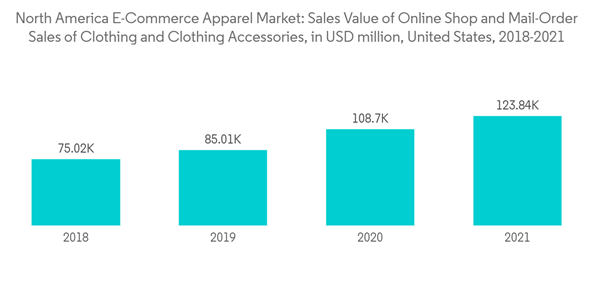Key Highlights
- The rising per capita income, the favorable demographics, and the shift in preference for branded products are projected to drive the demand for the market. The changing fashion trends and the evolving e-commerce landscape across brands have been the key factor for the booming e-commerce apparel market. Innovative designs, preferable fashion choices, and good marketing strategies are an advantage to the e-commerce apparel industry. Moreover, e-commerce apparel companies have customized mobile applications to showcase their products with all the required specifications, making customers place orders easily. The increased use of smartphones and the implementation of the 5G network for connectivity make the process flexible and flawless. The region has educated and digitally driven audiences. Due to the prominence of social media applications, marketing possibilities are abundant nowadays, which aids in propelling the e-commerce apparel market toward growth trajectories in the region.
- Furthermore, online clothing sales have increased significantly in recent years as consumers transformed more into comfortably shopping for clothing through their laptops and mobile devices. In addition, sustainable online shopping is also gaining attention. For instance, in April 2022, SHEIN, a leading online retailer of fashion apparel, announced the launch of evoluSHEIN, a new clothing line that was designed to make purposeful products accessible to its customers. The company claims that evoluSHEIN clothing features recycled polyester, a fiber obtained from plastic waste.
- Additionally, the market opportunities concerning this market include e-commerce sports apparel since there is an increase in health consciousness and an increase in fitness activities among customers, such as gym, yoga, running, etc., among consumers drive the market. Also, established sports companies have expanded their online presence subsequent to discovering the possibilities of e-commerce. Numerous well-known sports apparel companies associate with major online retailers or have dedicated e-commerce platforms, making their products readily available to customers. Therefore, the e-commerce sports apparel market is expected to gain significant market growth during the forecast period.
North America E-Commerce Apparel Market Trends
Increased Internet Usage and Effortless Shopping Experience
- Owing to the growing busy and hectic working environments, people are interested in preferring online mode of shopping. For instance, according to the World Bank Group Statistics, in 2022, North America in total has a 190.42 million working population, while the United States alone accounted for 169.27 million working population.
- As a result, consumers' inclination towards e-commerce apparel shopping is increasing because of the various advantages of online shopping, including the channel's distinctive features, such as product comparisons, wide assortment, and targeted incentives. However, consumers progressively prefer home delivery and value its product and service benefits, such as speed, reliability, assortment breadth, and flexibility.
- The e-commerce apparel company in North America has witnessed a rising emphasis on sustainable and ethical fashion. Consumers are turning more conscious of the environmental and social impact of their apparel purchases. To satisfy this demand, e-commerce platforms and manufacturers are offering sustainable and ethically sourced apparel solutions, such as organic materials, fair trade practices, and transparent supply chains. For instance, Wear Pact, Patagonia, Kotn, Tentree, Firebirds, and United By Blue, among others, are some of the sustainable e-commerce fashion brands across the region. These are the major reasons for the e-commerce apparel market growth in North America.
- Additionally, with the help of social commerce, and retail, the e-commerce brands divert traffic to their retail/company's websites, increasing their brand reach and building customer trust. Hence, the growth of social commerce results in an increase in the number of e-commerce orders. Further, with the help of social media campaigns and digital marketing, the companies gain customer reach. For instance, in May 2023, JD Williams' summer campaign was launched addressing fashion stereotypes. The company also states that its summer ad campaign was introduced as an online fashion e-tailer aiming to 'show women how to feel more girlfriend than grandma.'
United States is the Largest-Growing Market
- Customers in the United States have access to a wide range of retail outlets and online marketplaces, including Walmart, Amazon, eBay, etc. The convenience of having products delivered to their doorstep, the frequently lower prices, and the wider selection of products are three main reasons why American consumers usually purchase from online retailers. Further, the United States has a strong economy that further drives the e-commerce apparel market. According to the United States trade representative,
- Americans generate and earn more than 20% of the global economy. America has the largest national economy and is the leading trader in the world, despite making up fewer than 5% of the global population. This showcases their spending power. For instance, according to the U.S. Bureau of Economic Analysis data, consumer spending in the United States increased to USD 14,346.60 billion in the first quarter of 2023 from USD 14,214.90 billion in the fourth quarter of 2022.
- Additionally, Americans' inclination towards fashion drives the online clothing market segment. According to UNCOMTRADE, the import value of Articles of apparel and clothing accessories of furskin in 2022 accounted for USD 91.176 million, while the import value in 2023 accounted for USD 64.343 million. Therefore, the stats indicate the demand for apparel in this country. Further, the growing internet penetration and increasing digital marketing drive the e-commerce apparel market in the United States.
- Moreover, many social media platforms now include shoppable features that allow users to browse for and purchase products directly from the app. These features can be utilized by e-commerce apparel manufacturers to facilitate the purchasing process, creating a seamless experience for customers who discover products on social media and want to make an immediate purchase.
North America E-Commerce Apparel Industry Overview
The North America E-Commerce Apparel market is highly competitive owing to the presence of multiple regional and multinational companies offering a wide range of online apparel products and trying to maintain their leadership position in the market studied.Major players in the market include Ralph Lauren Corporation, VF Corporation, PVH Corp, Inditex, and Fast Retailing, each of which holds a significant share of the market studied. These players have been undertaking business strategies, including product innovations, partnerships, strengthening their hold over online and offline marketing, and mergers and acquisitions to expand their visibility and portfolio of offerings, thus, augmenting the growth of the market.
Further, the companies have been introducing new and innovative products with the inclusion of sustainable raw material fabrics to make their product unique from the existing products. Owing to the rapidly developing nature of the market and evolving trends in fashion, new product innovation has become the most commonly used strategy among all.
Additional Benefits:
- The market estimate (ME) sheet in Excel format
- 3 months of analyst support
This product will be delivered within 2 business days.










